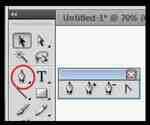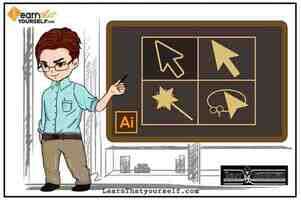Selection Tools in illustrator
Please Adobe, Stop Hiding the Tools.
Please Adobe, Stop Hiding the Tools.

Back in the olden days when dinosaurs ruled the earth and most of us had 12″ monitors it was important for software engineers to find ways of saving on screen real estate. In some cases they did this by putting tools in stacks. With a click and hold the tools would flyout and you could choose the right tool. For those of you unaware of how this works, just look at any Adobe application tool box. I’ll pick a random application, InDesign, for this demonstration. Check out the screenshot below:
Notice the small indicators telling me that there’s more here than meets the eye. If you click and hold any of these tools you’ll get a flyout allowing you to pick the alternate tools. (bonus tip, alt/opt+click any of these tools to toggle through the choices)
For example, the direct select tool and the postion tool occupy the same space on in the toolbox, but like Superman and Clark Kent they can never be seen in the same place at the same time.
I realize that saving screen real estate is still important but there’s plenty of room on today’s monitors for all of the tools to get equal treatment.
Adobe Suite: Using the Pen Tool
Some might not know this, but Adobe has many tools that are universal between the three main design programs: Illustrator, Photoshop, and InDesign. Even though they all handle different types of designs—Illustrator does vectors, Photoshop is photo editing and for some a painting program, and InDesign is a design text editor— all three are pretty much compatible and several of their tools perform the same functions. Some examples are the Type tool, the Pen tool, the Eyedropper tool, the Pencil tool, etc. However the main one today I would like to feature is the Pen tool.

The Pen tool is a tool that is typically something that a designer either loves or hates. I personally have a love hate relationship with it. And is an interesting feature, because it allows you to create your own shapes, vector images, and allows you to easily trace images. But you can also create text boxes with it as well.
Today’s tutorial though will cover the basics of the Pen tool, which is universally applicable to Illustrator, Photoshop, InDesign and After Effects. Since I have no experience with Adobe After Effects, I suggest going to this Adobe TV link for more information. However, if you would like to find out more about the other programs continue reading below. I will be showing the information in this tutorial through Adobe Illustrator, everything I will be doing is applicable in Photoshop and InDesign.
THE BASICS
The Pen Tool has several settings that help create shapes and effects. If you’ve never used the Pen Tool before, or are completely new to the Adobe Suite this is what it looks like in Adobe Illustrator:
The Pen Tool looks pretty much the same in Photoshop and InDesign, with the same features, just located in different places.
To use the Pen Tool just click on the pen icon in any program, and then just click on a blank canvas to begin designing your shape. I’ll go into more detail below about how to use the tool.
But the Pen Tool also has some subsidiary features, see the little box next to the Tool Panel, above. Those are all sub options that can be used to create designs. Illustrated below is what each are called, but here is a list of the options: Pen Tool, Adding Anchor Points, Deleting Anchor Points, and Converting Anchor Points (this in InDesign is Convert Direction Point Tool).
Photoshop also has a Freeform Pen Tool, show below, however I will not be going into that tool specifically in this tutorial. For those that know or don’t know Photoshop it is like the Lasso tool which allows you to free hand your selection of an object.
These tools will be explained at length once you learn how to create a shape.
CREATING A SHAPE
The basic tool you want to use of course is the Pen Tool to create your shape. Let’s trace an apple. To do so open up a blank canvas in one of the programs, and paste (Ctrl + V) or place (File > Place) in an apple photo.
Select the Pen Tool. And click once at the point where you would like to start the shape, you should get a blue dot like the one below, that dot is the beginning for your shape.
You then can begin clicking and adding additional points. Make sure that you have a fill color I decided to just make one shape of an apple like a shadow, so I chose red. Below is my beginning of out lining the stem.
Now the little trickier part getting into the curves of the apple and leaves. Now you make a point like you did before, but place the point where you want to curve the line to develop the shape of the leaf. Now do not let go, a black arrow will appear with two lines coming from the point you made. Drag that black arrow until your line is following the curve of the leaf, you can then let go.
To create the rest of the apple you the can use a combination of curved and straight lines, it results in an image like this.
Now that apple is a little messed up isn’t it? Here’s the original:
It looks like the original, but distorted, why? Because you need to convert your anchor points, which is simple. And is shown below, in the next part of the tutorial.
But for now this is what the apple should look like after you convert your anchor points:
CONVERTING ANCHOR POINTS
NOTE: In InDesign this feature is called Convert Direction Point Tool.
So while your designing you might notice that your curved points assume a certain curve every time, or begin to get ridge. To get rid of this you use the convert anchor points tool. Located as a sub option of the pen tool this takes a jagged line and makes it into a smooth curved one. Like this:
To accomplish this take the convert point tool and click on the bottom point of the jagged line. Then drag either to the right or left, until the line becomes the correct curve for your purposes. Here’s a screen shot of me doing it.
It is also built into the pen tool so that if you click on a point after you have already created the point, that point becomes fresh with no preset curves for the next portion of your design. You can then go ahead and keep creating! (This is what I did with the apple so that none of the preset curves affected the other ones, like it did with bad one.)
ADDING/DELETING ANCHOR POINTS
Anchor Points can be fickle, and the adding / deleting anchor points tools are helpful. Remember their are also other ones also available as subsidiaries to the pen tool.
To use either just select the tool from the tool panel. With the delete tool you just click on a point in the image that you would like remove, and it’s gone. For instance I removed a point from the apple image and this is what happened:
And then I was able to add it back in with the adding tool, resulting in the apple looking normal again (below). To add the point back in just click on a portion of the already developed line and then adjusted to where it needs to be.
There is a lot more things you can do with the pen tool. And I will be exploring one of those options, creating custom text boxes, in my next post, coming soon! But for right now here are some helpful videos and tutorial sites:
LRD Factory Pen Tool Video (Below):
Adobe TV Video: Tutorials all of the Programs
Adobe Offical Illustrator Tutorial Here
Advertisement
Selection Tools in illustrator
In this illustrator lesson, I will be talking about the Selection tools in Illustrator at LTY . My name is Lalit Adhikari, let’s get started.

These are four types of selection tools in the toolbar which is a bit similar to the ‘Selection Tools in Photoshop‘. They are named as Selection tool, Direct Selection Tool, Magic Wand Tool and Lasso Tool.
Related Topics:
Selection Tools in illustrator
The four types of selection tools in illustrator are as follow:
Selection Tool Direct Selection Tool Magic Wand Tool Lasso Tool
Four types of selection tools in illustrator
If you hover your cursor over the toolbar, it will show the name of the tool is and keyboard command shortcut. So for the Selection Tool, it’s V on your keyboard or for the Direct Selection Tool it’s A on your keyboard.
Selection Tool & Direct Selection Tool
The most frequently asked question in Adobe Illustrator is: What is the difference between Selection Tool and Direct Selection Tool? The first difference here is the appearance. The Selection Tool is black in color and the Direct Selection Tool is white in color.
Related Topics:
Selection tool
Selection Tool
The Selection Tool or Black Arrow, selects the entire object or shape. It is meant to select an object or shape to work with. If you Bounding Box is active then you can transform an object or shape using this tool. Transformation includes scaling up an object or scaling down, rotation and movement etc.
Here, let’s take a look at an example when our Bounding box is inactive:
Suppose you made a square and then chose Selection Tool. When you click on the shape with Selection Tool, you’ll notice that all the anchor points are selected.
Anchors shown as selected after using Selection Tool
You will not be able to grab any one of the anchor point and transform it. This tool can help you to move your object around the artboard.
Related Topics:
Direct Selection Tool
Direct Selection Tool used on a shape
This tool has an ability to manipulate the different anchor points or parts of the object so that you don’t necessarily have to draw shapes from scratch.
The Direct Selection Tool is a bit different from that. If you select the Direct Selection Tool from the toolbar, it will allow you to manipulate different part of this object.
You can also move the whole object from one place to another like the Selection Tool only when all corner anchor points are selected.
But in order to manipulate the part of the object, you have to click on it once and you will notice that all the different anchor points are now hollow except for that one particular anchor point that is filled or colored.
So, if you click and drag that particular anchor point it will allow you to manipulate that object in any way you want.
In addition, if you hold the shift key and click on another one or more than one anchor point, it will allow you to move those selected anchor points around as needed.
Therefore, it really allows you to create some unique objects from basic shapes.
Once you go ahead and start adding anchor points (by add anchor point tool), you can manipulate those anchor points by the Direct Selection Tool.
Related Topics:
Magic Wand Tool
Magic Wand Tool Options
Many of you might be familiar with Magic Wand Tool in Adobe Photoshop which is a part of Selection Tools in Photoshop. But as because Illustrator is a Vector based program and Photoshop is a Raster based Pixel program, you’ll also see a few differences with this tool.
To select this tool, you can either come up to the toolbar in the left-hand side of the interface or select it from right under the selection tool (black arrow) or you can also press Y on your keyboard for a shortcut.
The magic wand tool has the ability to select an object with similar traits. It can select objects with similar color, similar stroke weight, stroke color, opacity and blending mode etc.
If you double-click on the magic wand tool, a dialogue box will appear.
If you select the ‘fill color’ option and then select any of the objects with a color, let’s say (red), then it’s going to select all the objects that have the similar color of red.
option and then select any of the objects with a color, let’s say (red), then it’s going to select all the objects that have the similar color of red. Now, if you click on the ‘stroke color’ option and select an object, it will select all of the objects that have similar stroke color that you’ve selected the object with.
option and select an object, it will select all of the objects that have similar stroke color that you’ve selected the object with. If you select the option ‘stroke weight’ , it’s going to select all the objects that have a similar stroke weight.
, it’s going to select all the objects that have a similar stroke weight. If you select the ‘opacity’ option, it’s going to select all the objects that have similar opacity. For example, if some shape is at the opacity of 50% and you select it with the magic wand tool then it will automatically select every other shape which is at 50% opacity.
option, it’s going to select all the objects that have similar opacity. For example, if some shape is at the opacity of 50% and you select it with the magic wand tool then it will automatically select every other shape which is at 50% opacity. And the last option is the ‘Blending Mode’; and in this option, it’s going to select all the objects with the similar blending mode. For example, if you select any shape that is in the ‘multiply’ blend mode then it will select all the shapes that are in ‘multiply’ blend mode that is present in the artboard.
And these are the few options that are available in the ‘Magic Wand Tool’. You can select one of these options or all the options to get a more specific selection.
Related Topics:
Lasso Tool
Lasso Tool
The Lasso Tool has the ability to highlight with any object or point that you want to be selected. It’s somewhat similar to the Selection Tool.
The Keyboard shortcut for the lasso tool is Q . By this tool, you will be able to select as many objects as you want. All you have to do is hold down your mouse and outline the area surrounding the object.
Thus, you will be able to select all the objects or you can also select the points that make up the object.
The advantage of using a lasso tool is that you could select multiple anchor points in one go.
Although you can make selections of multiple anchor point with the direct selection tool too, but you can only able to make a marquee selection in order to get certain points.
But with the lasso tool, you can get more specific points which are not possible with the Direct Selection Tool.
If you are following our Free Illustrator Lessons and Tutorial Guide, then next you should read about, ‘How to Use Width Tool, Warp Tool, Twirl Tool, Pucker Tool, Bloat Tool, Scallop Tool, Crystallize Tool and Wrinkle Tool in illustrator‘.
Related Topics: